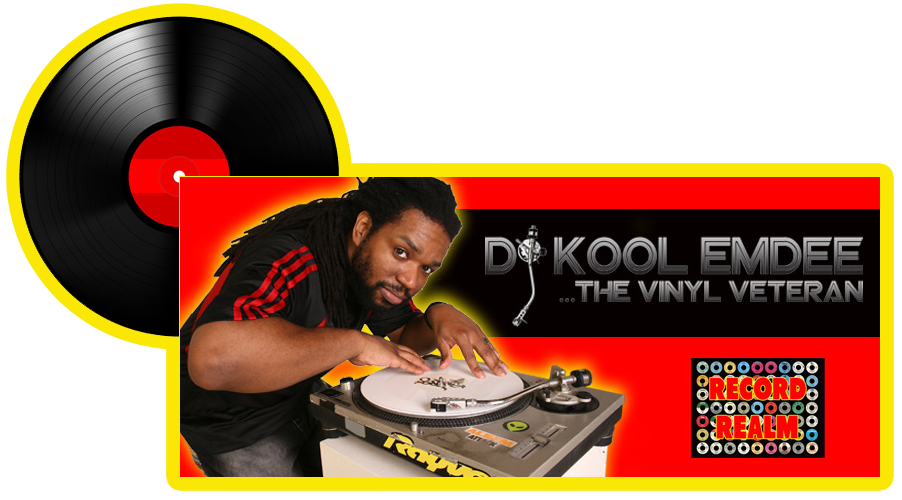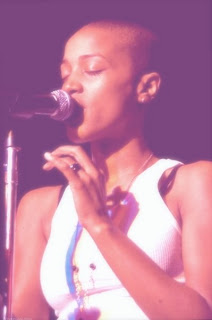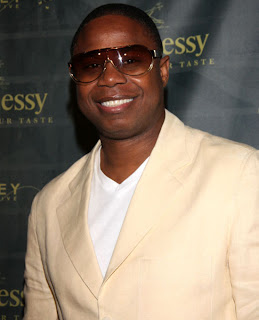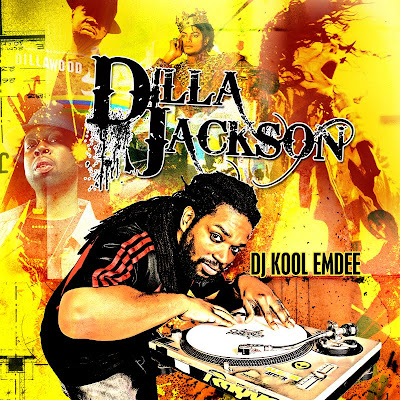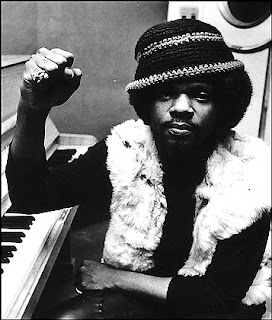The title of this post stems from a phrase James Brown is known to have said on one of his records (which led to the song being titled) to let the band know to give a "break" for his drummer Clyde Stubblefield, who is known as The Funky Drummer...
Clyde Stubblefield
Known largely for working with James Brown. His drum groove on James Brown's "Funky Drummer" may be the world's most sampled record. Other works by James Brown that Stubblefield played on include: "Cold Sweat", "There Was A Time", "I Got The Feelin'", "Say It Loud - I'm Black and I'm Proud", "Ain't It Funky Now", "Mother Popcorn", the album Sex Machine, and the remix of "Give It Up, or Turnit Loose" on In The Jungle Groove.
Max Roach
A pioneer of bebop and an one of the inventors the hard bop style of drumming, he has worked with many of the greatest jazz musicians, including Coleman Hawkins, Dizzy Gillespie, Charlie Parker, Miles Davis, Duke Ellington, Charles Mingus, Sonny Rollins and Clifford Brown.
Roach's most significant innovations came in the 1940s, when he and jazz drummer Kenny Clarke devised a new concept of musical time. By playing the beat-by-beat pulse of standard 4/4 time on the "ride" cymbal instead of on the thudding bass drum, Roach and Clarke developed a flexible, flowing rhythmic pattern that allowed soloists to play freely. The new approach also left space for the drummer to insert dramatic accents on the snare drum, "crash" cymbal and other components of the trap set.
By matching his rhythmic attack with a tune's melody, Roach brought a newfound subtlety of expression to his instrument. He often shifted the dynamic emphasis from one part of his drum kit to another within a single phrase, creating a sense of tonal color and rhythmic surprise. The idea was to shatter musical conventions and take full advantage of the drummer's unique position. "In no other society", Roach once observed, "do they have one person play with all four limbs."
Kenny Clarke
An early innovator of the bebop style of drumming, as well as an inventor of the hard bop style of drumming. As the house drummer at Minton's Playhouse in the early 1940s, he participated in the after hours jams that led to the birth of Be-Bop, which in turn led to modern jazz. While in New York, he played with the major innovators of the emerging bop style, Charlie Parker, Dizzy Gillespie, Thelonious Monk, Curly Russell and others, as well as musicians of the prior generation, including Sidney Bechet.
In the 1930s, while working in the bands of Edgar Hayes and Roy Eldridge, Clarke began experimenting with moving the time-keeping role from the combination of snare drum or hi-hat and bass drum to embellished quarter notes on the ride cymbal- the familiar "ding-ding-da-ding" pattern, which Clarke is often credited with inventing.
Art Blakey
Along with Kenny Clarke and Max Roach, he was one of the inventors of the modern bebop style of drumming. He is known as a powerful musician and a vital groover; his brand of bluesy, funky hard bop was (and remains) profoundly influential on mainstream Jazz. For more than 30 years his band the Jazz Messengers included many young musicians who went on to become prominent names in jazz.
From his earliest recording sessions with Eckstine, and particularly in his historic sessions with Monk in 1947, Blakey exuded power and originality, creating a dark cymbal sound punctuated by frequent loud snare- and bass-drum accents in triplets or cross-rhythms. Although Blakey discouraged comparison of his own music with African drumming, he adopted several African devices after his visit in 1948–9, including rapping on the side of the drum and using his elbow on the tom-tom to alter the pitch. His much-imitated trademark, the forceful closing of the hi-hat on every second and fourth beat, was part of his style from 1950–51.
Art Blakey appeared on an episode of The Cosby Show.
Mongo Santamaria
Afro-Cuban Latin-Jazz percussionist is famous for composing the Jazz standard "Afro Blue" and was an integral figure in the fusion of Afro-Cuban rhythms with R&B and Soul, paving the way for the "boogaloo" era of the late 1960s. His 1963 hit rendition of Herbie Hancock's "Watermelon Man" was inducted into the Grammy Hall of Fame in 1998.
Carlos "Patato" Valdes
He invented and patented the tunable conga drum (earlier drums had nailed heads) which revolutionized use of the instrument. For over 60 years Carlos "Patato" Valdez demonstrated how a musician could combine technical skill with superb showmanship. His conga playing demonstrated the fusing of melody and rhythm, and his keen understanding of rhythm is rooted in dancing. Patato even mastered the art of actually dancing ON TOP of his congas during his performances, to the delight of the audience.
Patato has recorded and toured with Tito Puente', Miguelito Valdes, Perez Prado, Beny More, 'Cachao' Lopez, Machito, Herbie Mann, Kenny Dorham, Cal Tjader, Art Blakey, Elvin Jones, Dizzy Gillespie, Quincy Jones, and Mario Bauza. Patato acted in and composed the title song of the Bill Cosby Show.
Willie Bobo
Made his name in Latin Jazz, specifically Afro-Cuban Jazz, in the 1960s and '70s, with the timbales becoming his favoured instrument. He met Mongo Santamaria shortly after his arrival in New York and studied with him while acting as his translator, and later at age 19 joined Tito Puente for four years.
His first major exposure was when he joined George Shearing's band on the album The Shearing Spell. After leaving Shearing, Cal Tjader asked Bobo and Santamaria to become part of the Cal Tjader Modern Mambo Quintet, who released several albums as the mambo craze reached fever pitch in the late '50s. Reuniting with his mentor Santamaria in 1960, the pair released the album Sabroso! for the Fantasy label. After the runaway success of Tjader's Soul Sauce, in which he was heavily involved, Bobo formed a new band with the backing of Verve Records, releasing Spanish Grease, of which the title track is probably his most well known tune. Highly successful at this attempt, Bobo released a further seven albums with Verve.
Billy Cobham
Acclaimed as one of Jazz fusion's greatest drummers and regarded as one of the best drummers in the world, Cobham is one of the first drummers to play open handed lead: a drummer that can lead (or ride) with either hand and begin or end a beat or fill with either hand (most drummers lead with 1 hand). He was also one of the first drummers to play with 3 or more snare and/or bass drums and multiple hi-hats.
He has worked with trumpeter Miles Davis, pianists Herbie Hancock and Horace Silver, also playing or recording with saxophonist Stanley Turrentine, organist Shirley Scott, and guitarist George Benson. In 1971, with fellow Davis alumnus guitarist John McLaughlin, Cobham co-founded Mahavishnu Orchestra, a definitive jazz fusion ensemble.
Tito Puente
Puente is often credited as "El Rey" (the King) of the timbales and "The King of Latin Music". He is best known for dance-oriented mambo and Latin jazz compositions that helped keep his career going for 50 years. He and his music appear in many films such as The Mambo Kings and Fernando Trueba's Calle 54. He guest starred on several television shows including The Cosby Show and The Simpsons.
Tony Allen
As drummer and musical director of Fela Anikulapo Kuti’s band Africa 70 from 1968 to 1979, Tony Allen was one of the primary co-founders of the genre of Afrobeat music. Fela once stated that, "without Tony Allen, there would be no Afrobeat."
A self-taught musician, Allen began to play drum-kit at the age of eighteen, while working as an engineer for a Nigerian radio station. Allen was influenced by music his father listened to (Juju, traditional Yoruba ceremonial music), but also American jazz, & the growing highlife scene in Nigeria and Ghana. Allen worked hard to develop a unique voice on the drums- feverishly studying LP's & magazine articles by Max Roach & Art Blakey, but also revolutionary Ghanaian drummer Guy Warren (now Kofi Ghanaba-who developed a highly sought sound that mixed tribal Ghanaian drumming with bop- working with Dizzy Gillespie, Charlie Parker, Thelonious Monk, and Max Roach).
In 1964, Fela Ransome Kuti invited Allen to audition for a jazz-highlife band he was forming. Kuti and Allen had played together as sidemen in the Lagos circuit. Fela complimented Allen’s unique sound: "How come you are the only guy in Nigeria who plays like this - jazz and highlife?" Thus Allen became an original member of Kuti’s "Koola Lobitos" highlife-jazz band.
In 1969, following a turbulent and educational trip to the U.S., Fela and the newly renamed Africa ’70 band developed a new militant African sound- mixing the heavy groove and universal appeal of James Brown’s soul with jazz, highlife, and the polyrhythmic template of Yoruba conventions. Allen developed a novel style to compliment Fela’s new African groove that blended these disparate genres.
Post-Fela, Allen developed a hybrid sound, deconstructing & fusing Afrobeat with electronica, dub, R&B, and rap. Allen refers to this synthesis as afrofunk.
Guy Warren or Kofi Ghanaba
a Ghanaian musician, best known as the inventor of Afro-jazz and as a member of The Tempos. He worked with leading jazz musicians such as Max Roach, Thelonious Monk, Lester Young and Charlie Parker.
He is also known by the honorary title Odomankoma Kyrema, meaning the Divine Drummer. Max Roach called him far more advanced than anyone of the time.
Babatunde Olatunji
Nigerian drummer, educator, social activist and recording artist, Olatunji was introduced to traditional African music and drumming at an early age. In the 1950s, while attending New York University to study public administration, he started a small percussion group to earn money on the side while he continued his studies.
Olatunji won a following among jazz musicians, notably creating a strong relationship with John Coltrane and Columbia Records A&R man John Hammond who signed him to the Columbia label in 1957. With Coltrane's help, he founded the Olatunji Center for African Culture in Harlem. In 1959 Olatunji released his first of six records on the Columbia label, called Drums of Passion. In 1969, Carlos Santana had a major hit with his cover version of this first album's "Jin-go-lo-ba," which Santana recorded on his debut album, Santana, as "Jingo." Olatunji favoured a big percussion sound, and his records typically featured more than 20 players, unusual for a percussion based ensemble. Drums of Passion became a major hit and remains in print; it introduced many Americans to world music. Drums of Passion also served as the band's name. Notable band members included; Clark Terry, Bill Lee, Horace Silver, Yusef Lateef, Sikiru Adepoju and Charles Lloyd, among others.
Olatunji recorded with many other prominent musicians, including Cannonball Adderley (on his African Waltz album), Horace Silver, Quincy Jones, Pee Wee Ellis, Stevie Wonder, Randy Weston, and with Max Roach and Abbey Lincoln on the pivotal Freedom Now Suite aka We Insist, and with Grateful Dead member Mickey Hart on his Grammy winning Planet Drum projects. Olatunji composed music for the Broadway theatrical and Hollywood film productions of Raisin in the Sun. He assisted Bill Lee with the music for his son Spike Lee's hit film She's Gotta Have It.
Buddy Miles
George "Buddy" Miles was known as a child prodigy, originally playing drums in his father, George Miles, Sr.'s, jazz band, The Bebops, beginning at age 12. Miles Sr. had played upright bass with Duke Ellington, Count Basie, Charlie Parker and Dexter Gordon.
Miles was most known as a member of Jimi Hendrix's Band of Gypsys from 1969 through to January 1970.
Rashied Ali
A free jazz and avant-garde jazz drummer best known for playing with John Coltrane in the last years of Coltrane's life. He has also recorded or performed with Pharoah Sanders, Alice Coltrane, Arthur Rhames, James Blood Ulmer and many others. Among his credits are the last recorded work of John Coltrane's life (The Olatunji Concert) and Interstellar Space, an album of duets with Coltrane recorded earlier in 1967. Ali "became important in stimulating the most avant-garde kinds of jazz activities".
Idris Muhammad
He is known for his funky playing style, has released a number of albums as leader, and has played with a number of jazz legends including Lou Donaldson, Johnny Griffin, Pharoah Sanders and Grover Washington, Jr. He has been touring and recording with pianist Ahmad Jamal since 1995. At 15 years-old, one of Muhammad's earliest recorded sessions as a drummer was on Fats Domino's 1956 smash hit "Blueberry Hill".
Elvin Jones
One of the great jazz drummers of the post-bop era who was a member of the John Coltrane quartet, a celebrated recording phase, appearing on such albums as A Love Supreme. Following his work with John Coltrane, Jones led several small groups, some under the name The Elvin Jones Jazz Machine. He recorded with both of his brothers during his career, jazz musicians Hank Jones and Thad Jones.
Elvin began his professional career in 1949 with a short-lived gig in Detroit's Grand River Street club. Eventually he went on to play with artists such as Charlie Parker, Miles Davis, and Wardell Gray. In 1955, after a failed audition for the Benny Goodman band, he found work in New York, joining Charles Mingus's band, and releasing a record called J is for Jazz.
In 1960, he joined with the classic John Coltrane Quartet, which also included bassist Jimmy Garrison and pianist McCoy Tyner. Jones and Coltrane often played extended duet passages, both giving and taking energy through their instruments. This band is widely considered to have redefined "swing" (the rhythmic feel of jazz) in much the same way that Louis Armstrong, Charlie Parker, and others did during earlier stages of jazz's development. Elvin Jones' sense of timing, polyrhythms, dynamics, timbre, and legato phrasing - as well as the sheer mass of sound he produced - brought the drumset to the foreground. Jones was touted by Life Magazine as "the world's greatest rhythmic drummer", and his free-flowing style was a major influence on many leading rock drummers.

He was born June 15, 1923, in Norassoba, Guinea, West Africa. Papa's fate was revealed to his parents by his maternal grandfather before he ever entered this world. His grandfather said that through the great sacrifices his family will have to endure, this third child would become one of the greatest drummers this world would ever know. His gift will take him from his native Guinea to Mali, Senegal, Europe, and America and in fact, throughout the world.
Ladji is known mostly for his work with various African dance companies, mainly Les Ballet Africans. Amongst his multiple performances around the world, he has also performed with the likes of dancer/choreographer Katherine Dunham, Babatunde Olatunji, Yusef Lateef, Mongo Santamaria, Nina Simone, Art Blakey & The Jazz Messengers, and Alvin Ailey.
Papa Jo Jones
I had to ask myself, "how could you forget to post one of the most influential drummers in the history of Jazz?" If you took a peek at the video clip, you should see why Papa Jo was well deserving of that title. Excellent showmanship, technique, precision, and his smooth transitions with polyrhythms, and not forgetting how he also changes it up by playing without his drum sticks, then goes back to playing with them flawlessly.
Jones worked as a drummer and tap-dancer at carnival shows until joining Walter Page's band, the Blue Devils in Oklahoma City in the late 1920s. He recorded with trumpeter Lloyd Hunter's Serenaders in 1931, and later joined pianist Count Basie's band in 1933. Jones, Basie, guitarist Freddie Green and bassist Walter Page are one of the more important rhythm sections in jazz.
He was one of the first drummers to promote the use of brushes on drums and shifting the role of timekeeping from the bass drum to the hi-hat cymbal. Jones is regarded as the premier jazz drummer of the Swing era, and the transitional figure between classic and modern jazz drumming. In contrast to big band drummer Gene Krupa's loud, insistent pounding of the bass drum on each beat, Jones often omitted bass drum playing altogether. Jones also continued a ride rhythm on high-hat while it was continuously opening and closing instead of the common practice of striking it while it was closed. Jones's style influenced the modern jazz drummer's tendency to play timekeeping rhythms on a suspended cymbal that is now known as the ride cymbal.
He had an incalculable influence on major drummers such as Buddy Rich, Kenny Clarke, Roy Haynes, Max Roach, and Louie Bellson. Jones performed regularly in later years at the West End Jazz Club at 116th and Broadway in New York City. These performances were generally very well attended by other drummers such as Max Roach and Roy Haynes, coming to pay court to an influential master.
Roy Haynes
Haynes is one of the most recorded drummers in jazz and in his over 60-year career has played in a wide range of styles ranging from swing and bebop to jazz fusion and avant-garde jazz. He has a highly expressive, personal style ("Snap Crackle" was a nickname given him in the 1950s) and is known to foster a deep engagement in his bandmates.
Haynes began his full time professional career in 1945. From 1947 to 1949 he worked with saxophonist Lester Young, and from 1949 to 1952 was a member of saxophonist Charlie Parker's quintet. He also recorded at the time with pianist Bud Powell and saxophonists Wardell Gray, and Stan Getz. From 1953 to 1958 he toured with singer Sarah Vaughan. Haynes went on to work with more experimental musicians, like saxophonists John Coltrane and Eric Dolphy, or pianists Chick Corea and Andrew Hill.
Haynes has recorded or performed with Gary Burton, Miles Davis, Dizzy Gillespie, Henry Grimes, Christian McBride, Jackie McLean, Chick Corea, Pat Metheny, Thelonious Monk, Gerry Mulligan, Art Pepper, Sonny Rollins, Horace Tapscott and many others. He has also led his own groups, some performing under the name Hip Ensemble. His most recent recordings as a leader are Fountain of Youth and Whereas, both of which have been nominated for a Grammy Award. He continues to perform worldwide.
Philly Joe Jones
Known as the drummer for the Miles Davis Quintet. Davis also described Jones' style of playing as "that Philly Joe lick". In 1947 he became the house drummer at Café Society in New York City, where he played with the leading bebop players of the day. The most important influence on Jones among them was Tadd Dameron.
Jones then toured and recorded with Miles Davis Quintet from 1955 to 1957 — a band that became known as "The Quintet", and is regarded by many as one of the greatest groups in the history of jazz. From 1958 onwards he worked as a leader, but continued to work as a sideman with other musicians, including Bill Evans and Hank Mobley. Miles acknowledged Jones as his favorite drummer, while Evans openly admitted Jones as being his all-time favorite drummer.
Narada Michael Walden
With a music career spanning more than three decades, Walden got a huge boost by playing with John McLaughlin's Mahavishnu Orchestra, after replacing Billy Cobham. He has a signature drum pattern known by other drummers as the "10 note drum lick/fill", which is a combination of bass kicks, snare taps, and toms in a specific pattern.
Along with his skills as a session drummer, Walden is also a gifted songwriter, producer, and vocalist. Billboard Magazine lists him as one of the Top 10 Producers of All Time. This multi-Grammy Award winning and Emmy Award winning artist has written and/or produced for Aretha Franklin, Whitney Houston, Mariah Carey, Ray Charles, Diana Ross, George Michael, Sting, Wild Orchid, Tevin Campbell, Angela Bofill, Steve Winwood, Regina Belle, Andy Vargas, Debelah Morgan, Jermaine Stewart, and many more, leading to him becoming a multi-platinum selling artist on various projects.
Walden also adds to his resume by working on the soundtracks The Bodyguard and Stuart Little, as well as the Emmy Award winning theme for the 1988 Olympics, "One Moment In Time".
